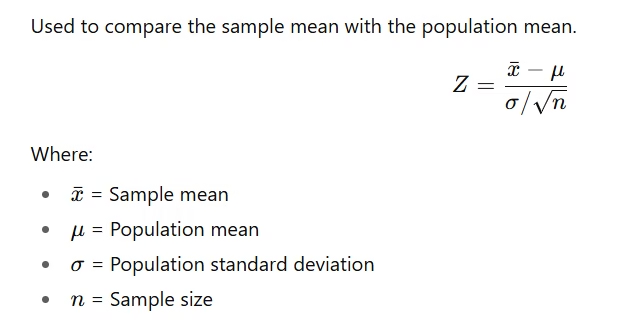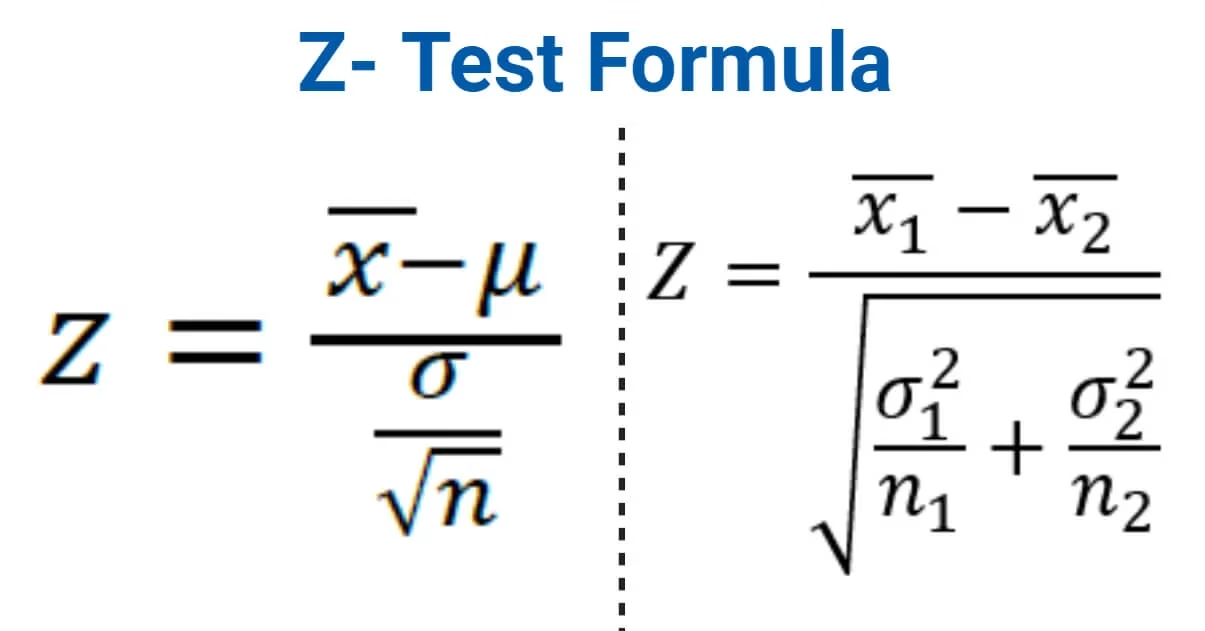Statistical tests are essential in research because they help researchers evaluate data, test hypotheses, and draw meaningful conclusions. One of the most widely used statistical methods in biology, psychology, medicine, and social sciences is the Z-test.
This article explains the Z-test in detail, including its definition, formula, assumptions, types (one-sample, two-sample, one-tailed, two-tailed), examples, applications, and differences from the t-test.
1. What is the Z-test?
- The Z-test is a parametric statistical test used to determine whether there is a significant difference between a sample and a population, or between two independent samples.
- It is based on the normal distribution and is particularly useful when:
- The sample size is large (n > 30)
- The population variance (σ²) or standard deviation (σ) is known.
- The test converts data into a z-score, which represents how many standard deviations a sample mean is from the population mean.
Example: If the average height of a sample of workers is 67.47 inches, and the known population mean is 67.39 inches with a standard deviation of 1.30, a Z-test can be used to check if the difference is statistically significant.
2. Key Features of the Z-test
- Based on the normal probability distribution.
- Requires large sample sizes (n > 30).
- Assumes population variance is known.
- Provides a z-score that measures how far data is from the mean.
- More convenient than the t-test because the critical values remain constant for all large samples.
3. Assumptions of Z-test
For a Z-test to be valid, the following conditions must be satisfied:
- The data follows a normal distribution.
- The sample is drawn randomly from the population.
- Observations are independent of each other.
- The population variance or standard deviation is known.
- The sample size should be large (n > 30).
4. Z-test Formula
(A) One-sample Z-test
Used to compare the sample mean with the population mean.

(B) Two-sample Z-test
Used to compare the means of two independent samples.

5. Types of Z-tests
1. One-sample Z-test
- Compares the mean of a sample with the known population mean.
- Example: Testing whether the average height of a group of plants differs from the known population mean.
2. Two-sample Z-test
- Compares the means of two independent samples.
- Example: Testing whether two fertilizers result in different average crop yields.
3. One-tailed Z-test
- Tests whether the sample mean is significantly greater than or less than the population mean.
- Used when the direction of difference is specified in advance.
4. Two-tailed Z-test
- Tests whether the sample mean is different (either higher or lower) from the population mean.
- Used when no specific direction is expected.
6. Steps in Performing a Z-test
- State the null hypothesis (H0): No significant difference exists.
- State the alternative hypothesis (H1): A difference exists.
- Choose the level of significance (α), usually 0.05.
- Calculate the test statistic (Z) using the formula.
- Compare the calculated Z-value with the critical Z-value from the standard normal distribution table.
- Draw a conclusion:
- If calculated Z > critical Z, reject H0.
- If calculated Z ≤ critical Z, fail to reject H0.
7. Z-test Example
A sample of 400 male workers has a mean height of 67.47 inches. The population mean is 67.39 inches with a standard deviation of 1.30 inches. Is the difference significant at a 5% level?

8. Applications of Z-test
- Biology & Medicine:
- Testing effectiveness of a drug compared to known results.
- Comparing average growth of treated vs untreated plants.
- Education:
- Comparing exam scores of two student groups.
- Business & Marketing:
- Testing whether two products have different average sales.
- Social Sciences:
- Checking if survey results differ significantly from expected values.
9. Z-test vs T-test – Key Differences
| Basis | T-test | Z-test |
|---|---|---|
| Sample Size | Small (n ≤ 30) | Large (n > 30) |
| Population Variance | Unknown | Known |
| Distribution | t-distribution | Normal distribution |
| Convenience | Different critical values for different n | Same critical values for all large n |
| Use Case | Small samples, unknown σ | Large samples, known σ |
| Applications | Comparing means in small samples | Comparing means and proportions in large samples |
10. Advantages of Z-test
- Easy to calculate and apply.
- Works well with large samples.
- More reliable when population variance is known.
- Suitable for both one-tailed and two-tailed tests.
- Widely used in biological, medical, and social research.
11. Limitations of Z-test
- Requires large sample sizes.
- Not suitable when population variance is unknown.
- Assumes normal distribution, which may not always hold true.
- Less accurate for small samples (t-test is better in such cases).
12. Conclusion
The Z-test is a fundamental statistical tool in research methodology that helps determine whether differences in means or proportions are significant or due to chance.
- One-sample Z-test compares a sample mean to a population mean.
- Two-sample Z-test compares means of two independent groups.
- It can be one-tailed (directional) or two-tailed (non-directional).
While it has limitations, especially with small samples, it remains one of the most powerful and widely used tests in biological, medical, and social research.
Frequently Asked Questions (FAQs) on Z-test in Research Methodology
1. What is the Z-test in simple words?
The Z-test is a statistical test used to check if there is a significant difference between a sample and a population mean, or between two independent sample means, when the population variance is known and the sample size is large.
2. When should I use a Z-test?
You should use a Z-test when:
- The sample size is large (n > 30).
- The population standard deviation (σ) is known.
- The data follows a normal distribution.
3. What are the types of Z-tests?
- One-sample Z-test – Compares a sample mean to the population mean.
- Two-sample Z-test – Compares means of two independent samples.
- One-tailed Z-test – Tests if the sample mean is significantly higher or lower.
- Two-tailed Z-test – Tests if the sample mean is significantly different in either direction.
4. What is the difference between Z-test and t-test?
- Z-test: Used for large samples (n > 30) when population variance is known.
- T-test: Used for small samples (n ≤ 30) when population variance is unknown.
5. Can I use Z-test for small samples?
No, the Z-test is not reliable for small samples. In such cases, the t-test should be used because it adjusts for small sample sizes and unknown variance.
6. What does the Z-value represent?
The Z-value (or Z-score) shows how many standard deviations the sample mean is away from the population mean. A higher Z-value indicates a larger difference.
7. What is the critical value in Z-test?
The critical Z-value depends on the level of significance (α):
- At α = 0.05 (two-tailed), critical Z = ±1.96.
- At α = 0.01 (two-tailed), critical Z = ±2.58.
If the calculated Z exceeds the critical Z, the null hypothesis is rejected.
8. Where is the Z-test used in real life?
- Biology & Medicine: Checking if a new drug works better than a standard treatment.
- Agriculture: Comparing crop yields with two fertilizers.
- Education: Comparing test scores of different student groups.
- Business: Analyzing sales differences between two products.
9. What are the limitations of the Z-test?
- Requires large sample sizes.
- Needs population variance to be known.
- Assumes normal distribution of data.
- Not suitable for small samples or non-normal data.
References
- C.R. Kothari (1990) Research Methodology. Vishwa Prakasan. India.
- https://ncss-wpengine.netdna-ssl.com/wp-content/themes/ncss/pdf/Procedures/PASS/One-Sample_Z-Tests.pdf
- https://microbenotes.com/z-test/
- https://www.coursehero.com/file/61052903/Questions-statisticswpdf/
- https://towardsdatascience.com/everything-you-need-to-know-about-hypothesis-testing-part-i-4de9abebbc8a
- https://ncss-wpengine.netdna-ssl.com/wp-content/themes/ncss/pdf/Procedures/PASS/One-Sample_Z-Tests.pdf
- https://www.slideshare.net/MuhammadAnas96/ztest-with-examples
